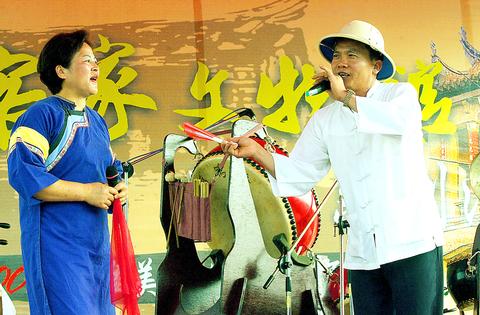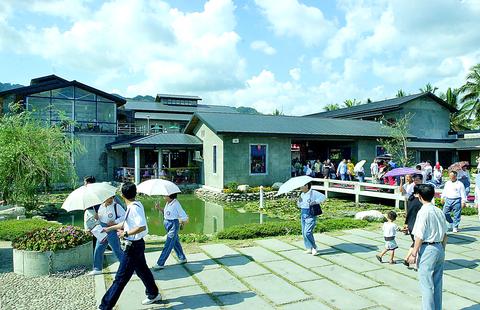Its been nearly seven years, but finally the NT$120 million Hakka museum in Meinung township officially opened yesterday in a colorful ceremony at which President Chen Shui-bian (陳水扁) put in an appearance. Hakka culture, like many other minority cultures around the world, is receiving greater recognition by government agencies, and while this museum is far from the first to be devoted to Hakka culture, it is remarkable for its effort to become an integral part of the Hakka community in Meinung.
President Chen used the opening of the museum to emphasize the government's efforts to preserve Hakka culture and give it the recognition it deserves. Hakka people represent about 15 percent of Taiwan's population, and in townships such as Meinung, Hakka people make up over 90 percent of residents. The Hakka, who traditionally have emphasized education even more than most Chinese, are disproportionately represented in the upper levels of academia and government, and current legislation is being reviewed that will create a central government agency for Hakka affairs.

PHOTO: CHEN CHENG-CHANG, TAIPEI TIMES
The museum, designed by the Hakka architect Hsie Ying-jun (謝英俊) is a modernized representation of a traditional tobacco smoke house. These buildings, which used to dominate the landscape in Meinung, have now largely fallen into disrepair, as the government tobacco monopoly has reduced its purchases of local product. Nevertheless, smoke houses are a potent symbol of Meinung, for it was the tobacco industry which provided the economic foundations for earlier generations of highly-educated Hakka people.

PHOTO: CHEN CHENG-CHANG, TAIPEI TIMES
A number of smoke houses have been converted to recording studios, the best known of which is probably the one owned by Labor Exchange (交工樂隊), a local folk rock group.
Wang Hsiu-mei (王秀美), who has worked with the museum over the last three years in its preparation phase, said that an important aspect of the museum's concept is as a community museum. The exhibits, dedicated to all aspects of daily life in Meinung, has a slight feel of a beleaguered community protecting its identity, not that this makes the show any less interesting.
Margaret Wang (王長華), director of the Kaohsiung City Government's Cultural Bureau and head of the museum, pointed out that the Hakka of Meinung, with their almost obsessive respect for education and the written word, have maintained exhaustive records of their community, providing a uniquely solid foundation for the work of cultural preservation. Unfortunately, it is this emphasis on the written word that makes the museum hard going, and tends to emphasize its role as a cultural preservation project. But for those with the time and inclination, the combination of audiovisual elements, with extensive texts and photographic material, along with a comprehensive collection of local publications on Hakka culture, make it an invaluable resource.
The museum's association with Meinung differentiates it from other Hakka cultural centers around the island. "The Taipei and Kaohsiung Hakka cultural centers are cultural facilities forcibly grafted into an alien environment," Margaret Wang said. "Here we are an organic part of the environment."
The museum is located among uncluttered fields, and provides a focus for the scattered tourism attractions of the Meinung area, such as old smoke houses and Butterfly Valley (黃蝶翠谷). "We hope it will serve the role of an information center for the area," Margaret Wang said. Another role the museum aims to play is that of a Hakka community center, were Hakka people will have a chance to get in touch again with their culture.
Although currently operated by the Kaohsiung County Cultural Bureau, Wang said that consideration is already being given to handing the venue over to private interests in the next few years in line with a government policy of localization in which communities take on an increasing responsibility for their cultural and tourism resources.
What: Kaohsiung County Meei-nong The Hakkas Museum (高雄縣美濃客家文物館)
Where: 49-3, Minchu Rd., Meinung Township, Kaohsiung County (高雄縣美濃鎮民族路49之3號)
Open: 10am to 4pm (closed Monday and public holidays)
Free entry.
On the Net: http://www.kccc.gov.tw

April 14 to April 20 In March 1947, Sising Katadrepan urged the government to drop the “high mountain people” (高山族) designation for Indigenous Taiwanese and refer to them as “Taiwan people” (台灣族). He considered the term derogatory, arguing that it made them sound like animals. The Taiwan Provincial Government agreed to stop using the term, stating that Indigenous Taiwanese suffered all sorts of discrimination and oppression under the Japanese and were forced to live in the mountains as outsiders to society. Now, under the new regime, they would be seen as equals, thus they should be henceforth

Last week, the the National Immigration Agency (NIA) told the legislature that more than 10,000 naturalized Taiwanese citizens from the People’s Republic of China (PRC) risked having their citizenship revoked if they failed to provide proof that they had renounced their Chinese household registration within the next three months. Renunciation is required under the Act Governing Relations Between the People of the Taiwan Area and the Mainland Area (臺灣地區與大陸地區人民關係條例), as amended in 2004, though it was only a legal requirement after 2000. Prior to that, it had been only an administrative requirement since the Nationality Act (國籍法) was established in

With over 80 works on display, this is Louise Bourgeois’ first solo show in Taiwan. Visitors are invited to traverse her world of love and hate, vengeance and acceptance, trauma and reconciliation. Dominating the entrance, the nine-foot-tall Crouching Spider (2003) greets visitors. The creature looms behind the glass facade, symbolic protector and gatekeeper to the intimate journey ahead. Bourgeois, best known for her giant spider sculptures, is one of the most influential artist of the twentieth century. Blending vulnerability and defiance through themes of sexuality, trauma and identity, her work reshaped the landscape of contemporary art with fearless honesty. “People are influenced by

Three big changes have transformed the landscape of Taiwan’s local patronage factions: Increasing Democratic Progressive Party (DPP) involvement, rising new factions and the Chinese Nationalist Party’s (KMT) significantly weakened control. GREEN FACTIONS It is said that “south of the Zhuoshui River (濁水溪), there is no blue-green divide,” meaning that from Yunlin County south there is no difference between KMT and DPP politicians. This is not always true, but there is more than a grain of truth to it. Traditionally, DPP factions are viewed as national entities, with their primary function to secure plum positions in the party and government. This is not unusual